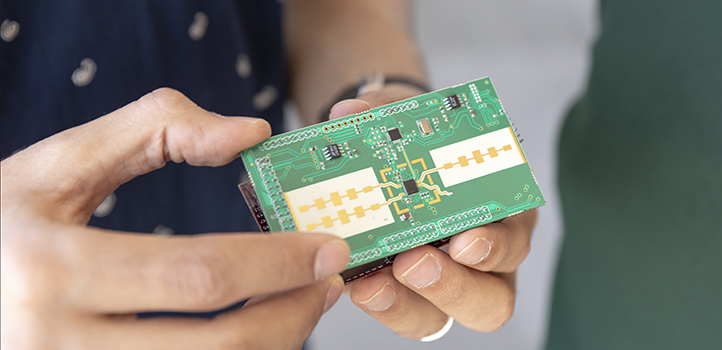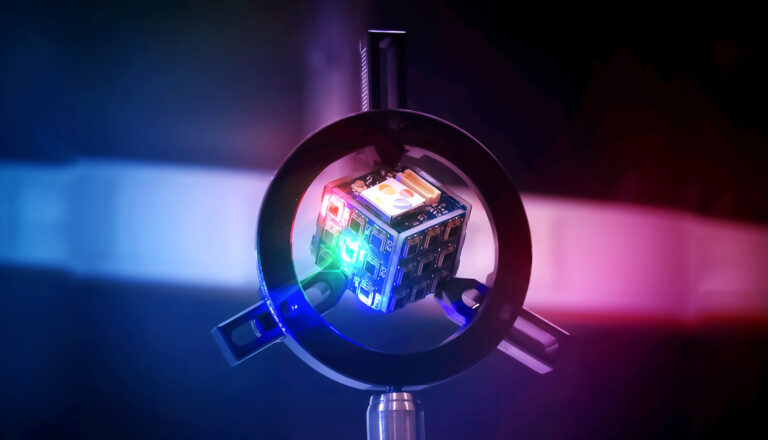Electrical Engineering
Tiny, fast, accurate technology on the radar
A tiny, portable radar device could allow visually impaired people, or unmanned moving devices, to detect objects in real time.

In collaboration with scientists at the VTT Technical Research Center of Finland, KAUST scientists have created a compact, low-cost radar with potential applications in health-care and personal security.
© 2019 KAUST
Radar technology has been used for decades in aviation, defense and speed-camera technology. Now, a team at KAUST, in collaboration with scientists at the VTT Technical Research Center of Finland, have created a compact, low-cost radar with potential applications in healthcare and personal security.
Radar provides detailed information about the size, distance and speed of moving objects. However, for close-range applications, the transmitted radio waves must have short wavelengths to pick up as much detail as possible about their immediate environment. Such sensors could help visually impaired people, and unmanned moving devices, to “see” by translating radar reflections into useful information.
“Current radar modules are large and bulky. They also miss key details because they operate using long radio wavelengths,” says Seifallah Jardak, who worked on the project under the supervision of Sajid Ahmed and Mohamed-Slim Alouini from KAUST along with Tero Kiuru and Mikko Metso from VTT. “We wanted to develop a low-power, portable radar. Colleagues at VTT brought the necessary experience in millimeter-wave and hardware design, while I focused on the signal processing side and developed modular radar software,” explains Jardak.

Seifallah Jardak (left) discusses his radar device with supervisor Mohamed-Slim Alouini.
© 2019 KAUST
The earliest prototype performed a single scan every two seconds, making it difficult to acquire enough input data. Jardak optimized the signal processing modules and improved the performance to eight scans per second, providing better real-time monitoring.
The device design incorporates a frequency-modulated continuous wave (FMCW) radar. This means that the radar produces continuous pulses of millimeter-wavelength radio waves that have a frequency that varies during each pulse. The small wavelength means that the time taken for pulses to reach an object and reflect back, and therefore the distance to the object, are calculated accurately.
“To limit the size of our system, we chose an operating frequency of 24 Gigahertz. This enabled us to reduce the size of the microstrip antenna,” says Jardak. “Our design also has one transmitting and two receiving antennae, meaning it can better estimate the angular location of a target.”
The device fits into a 10 centimeter box, weighs less than 150 grams and is powered by a five volt battery. Initial trials suggest that the device is capable of target detection, speed estimation and tracking at ranges of up to 12 meters. The team even used it to detect whether a person was breathing when sitting in a chair.
“Our prototype may also be useful for unmanned robotic and quadcopter applications where a collision avoidance system is required,” adds Jardak.
References
-
Jardak, S., Kiuru, T., Metso, M., S. Ahmed, S. & Alouini, M.-S. Low-cost compact FMCW radar: Hardware and software implementation. IEEE Aerospace & Electronic Systems Magazine, 34, 36-44 (2019).| article
You might also like

Bioengineering
Sensing stress to keep plants safe

Computer Science
Sweat-sniffing sensor could make workouts smarter

Electrical Engineering
New tech detects dehydration by touching a screen

Electrical Engineering
A new interface for efficient electronics

Electrical Engineering
Artificial neurons enable neuromorphic computing with light

Electrical Engineering
Narrow-linewidth lasers bring low-noise answer

Electrical Engineering
Octopus suckers inspire sticky medical patch

Electrical Engineering




